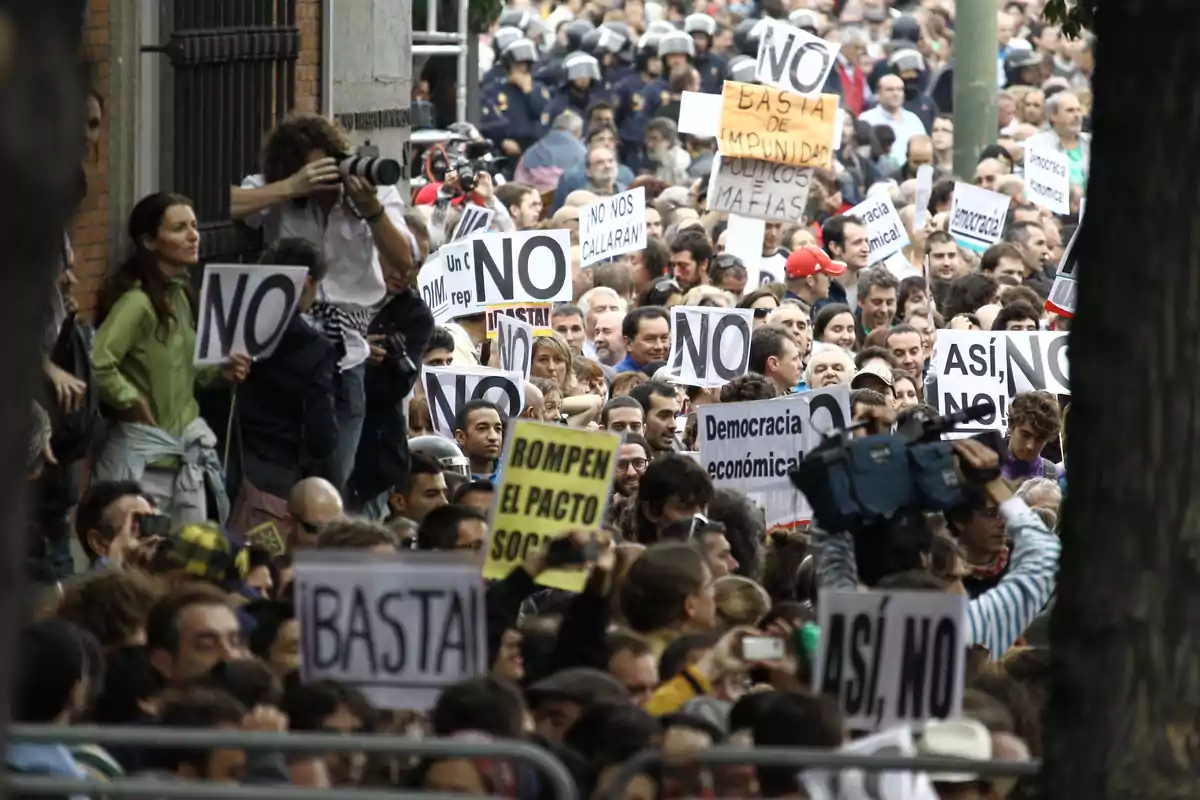
14 years since 15-M: the movement that ended bipartisanship in Spain
An economic crisis and imminent elections caused the Spanish people to protest in May 2011
Movement 15-M emerged on May 15, 2011, in Spain. That day, thousands of people demonstrated in different cities, especially in Madrid. They protested against unemployment, political corruption, the power of banks, and the lack of democratic representation.
It was initially driven by groups like Real Democracy Now and Youth Without Future. It became a social phenomenon with massive camps, especially in Madrid's Puerta del Sol.
"Without the 2008 financial crisis, the so-called 15M movement wouldn't have existed," explained Pablo Gallego, a member of the Real Democracy Now platform.

That 15M, the squares of several cities in Spain were filled with people who replied to calls on social media. A tool that "allowed us to connect each one's individual complaints," explained Klaudia Álvarez from "We, the Indignant."
These people didn't belong to a single social stratum. Retirees, students, unemployed, or salaried workers began to demonstrate that May 15. For weeks afterward, they went on to camp.
It didn't matter if it was in tents or sleeping on cardboard. The only thing that mattered was protesting to achieve a better world. The most emblematic place that could be chosen was Madrid's Puerta del Sol.
A social movement, a political critique
Away from unions or political parties, the movement was organized with a horizontal model, without an identified leader. Its demands were heterogeneous and tended toward idealism. They denounced the excesses of capitalism, precariousness, and the electoral system, which favored the major parties.
There were so many complaints that the movement attracted criticism due to the present ideological confusion. "It was non-partisan, non-union, but very political," noted Pablo Gallego about the movement he remembers "with much affection" for being "very romantic" and made up of people "who weren't activists."
"They don't represent us" and "let them go," shouted the protesters, while they prevented evictions of indebted families. They sought to show their frustration with the crisis and the austerity imposed by the troika (EU, IMF, and ECB). All this, in a country ravaged by a record unemployment that later affected almost half of those under 25 years old.

They coordinated on social media with a campaign at the same time and with the same messages on a hundred Twitter profiles. This created a Trending Topic that captured the attention of all the media.
Puerta del Sol became a symbol of protest. In this place, the protesters formed a new way of communicating to try to shorten the endless assemblies. Hands in the air, in favor; hands turning, the speaker repeats; crossed arms, in disagreement.
The socialist government of Rodríguez Zapatero, surprised by this movement with broad popular support, didn't know very well how to react and didn't order the eviction of the square. This allowed #SpanishRevolution to intensify and other camps to emerge.
After 15M, the end of bipartisanship
In mid-June, the indignant withdrew promising to remain present. This protest would spread to France, Greece, and New York. It reached the American city with the "Occupy Wall Street" movement in September 2011.
As a result of this revolution, three years later a new radical left political party, Podemos, emerged. This catalyzed much of the ideals of 15M.
But a large number of the indignant rejected that it was the only party that emerged after these protests. And indeed, the 15M movement also served as a springboard for other political parties like Ciudadanos.

However, Podemos was the clearest materialization of the movement started in May. The party, which was created by university professors, quickly rose to become the third political force in the country.
With this, it ended the hegemonic bipartisanship that reigned in Spain for decades. Additionally, it achieved a surprise result in the 2014 European elections.
Its leader at that time, Pablo Iglesias, who was part of the indignant, held one of the vice presidencies of the Spanish government between January 2020 and March 2021, proving that 15M managed to go very far.
"A phenomenon that politicized an entire generation of Spaniards"
The indignant "were sponsored by practically all the parties in Spain," wrote Pablo Simón, a Political Science professor at Charles III University of Madrid, for whom the movement was born "from that disenchantment with traditional politics."
In his opinion, it was "a phenomenon that politicized an entire generation of Spaniards, especially those born from the 1980s onwards."
Fourteen years later, the rebels of Puerta del Sol are less indignant. They believe, at least, to have laid the foundations for the fight against climate change. Or to have contributed to the gigantic feminist demonstrations.

In all this time, many things have changed in Spanish politics. The Platform for Mortgage Victims (PAH) emerged, and from it, a mayor of Barcelona. Podemos arrived, and with it a vice president of the Government and several ministers.
The rise of the movement occurred with the June demonstration and the subsequent one in October 2011. Groups like @democraciareal, @acampadasol, or the @yayoflautas experienced their moments of glory during the summer and part of the fall. However, the winter dissolved the movement and drove it off the streets, although it continued on social media like Twitter and Facebook.
After 15M, and with the change from a socialist government to a PP government, the "tides" would arrive as heirs of that movement. A movement that during the spring of 2011 could have meant the change that never really came.
More posts: